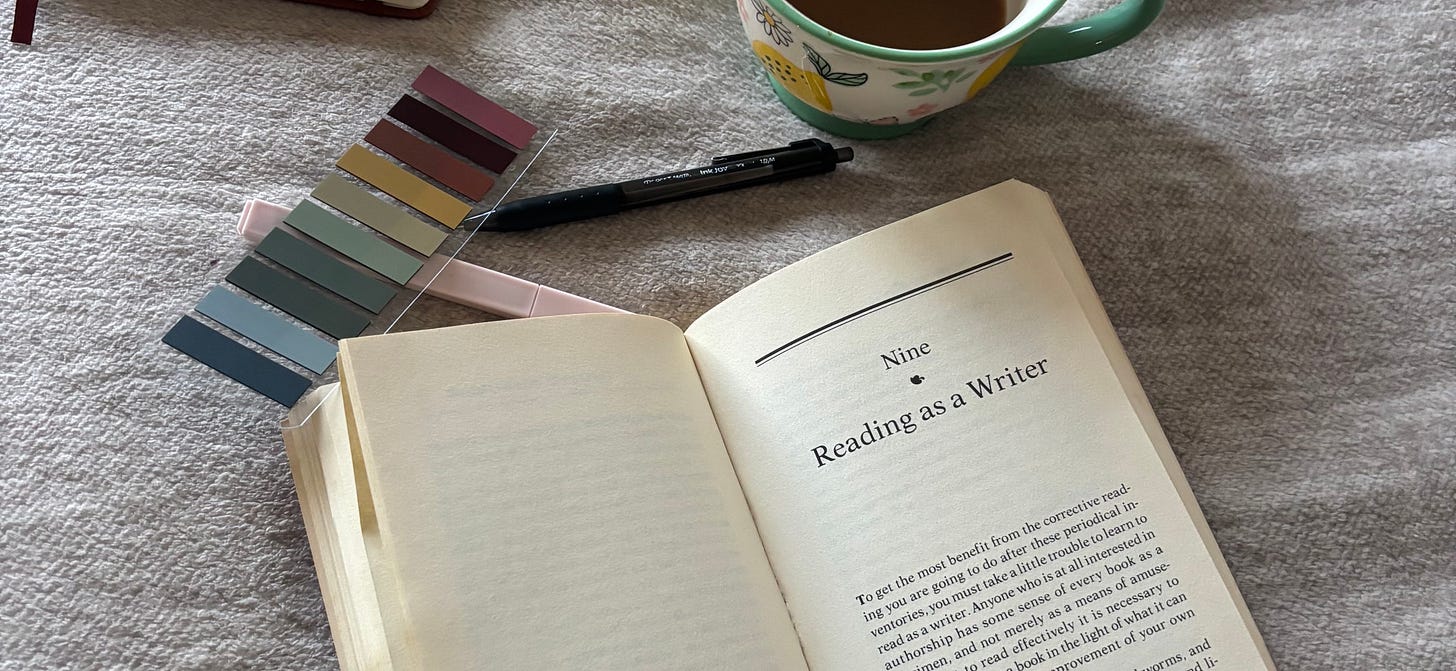Reading as a writer
How to use reading to help you become a better writer. Wisdom drawn from dorothea brande's book "becoming a writer"
Although I’ve always loved reading and writing, the idea of becoming a writer once felt elusive and intimidating. I didn’t know what kind of writer I wanted to be or how to develop a unique voice and tone. I often doubted my creativity, questioning whether I could write with artistry or originality. It wasn’t until I began reading more that I started to recognize the types of writing I admired and the qualities I wanted to cultivate in my own work.
For those who appreciate the art of writing, reading isn’t merely an act of consumption but a deeply intimate and layered process. For writers, it’s not just about the story told, but about how it’s told. Every word on the page is purposefully chosen, strung into sentences that guide readers through distant worlds, thought-provoking research, and the depths of human experience.
Many people, including myself, read for different reasons: some to gain knowledge, others to experience adventure, thrill, understanding, or connection. But beyond being a hobby or tool for self-education, reading can also serve as inspiration and a guide to becoming a better writer.
As Dorothea Brande explains in her book Becoming a Writer, “But to read effectively, it is necessary to learn to consider a book in the light of what it can teach you about the improvement of your work [writing].” For Brande, reading is no longer a surface-level activity. Writers must read with a critical eye, focusing on style, structure, and the techniques an author uses to convey their ideas.
To read like a writer, Brande suggests reading every book, article, or essay twice.
As she puts it, “At first, you will find that the only way to read as a writer is to review everything twice.” The first time you read, do so (somewhat) uncritically, immersing yourself in the content without deep analysis.
Afterward, grab a pen and notebook to reflect on what you’ve just read. Start by summarizing the text, followed by a general analysis. It’s okay if your initial thoughts are vague (that’s what the second reading is for, where your analysis will be more critical and in-depth).
.To help guide your general analysis, here are a few questions to consider after your first read:
What’s the book, article, or essay about?
What did you like about it? What didn’t you like?
How would you rate the dialogue? What stood out to you about it?
Which characters did you find compelling or not?
Which sections or scenes did you like or dislike?
How would you describe the author’s writing style?
Does this author address any challenges you face in your own writing (dialogue, plot, themes, prose, etc.)?
After you’ve finished your first round of reading and general review, Brande recommends returning to the text a second time, using your notes to guide you through a more critical analysis of the writing.
During the second reading, focus on examining key elements like the author’s main ideas, character development, and narrative structure. Revisit important dialogue or scenes and analyze their significance. Look closely at the author's literary tools (such as themes, foreshadowing, metaphors, and imagery) and consider whether these techniques resonate with you or offer ideas for your writing. As you analyze what you like and dislike in an author’s writing, you can apply these insights to your work.
Some literary devices to analyze/consider:
Themes
Foreshadowing
Allegories
Irony
Metaphors
Imagery
Juxtapositions
Similes
Over time, as you become a stronger reader and writer, you'll find that you no longer need to read a book twice to analyze it critically. Your analytical and creative skills will sharpen, and your ability to write exceptional work will grow.
As you explore a wide range of authors and genres, let yourself draw inspiration from each of them. Gradually cultivate your unique voice and style—and when you're ready, publish your work, which might inspire and help fellow writers hone their craft.
Thank you for reading and your support! Subscribe for more reading, learning, thinking, and writing-related content.


Loved this piece! What resonated most was the shift from reading for information to reading for discernment.
The idea of reading twice, once to feel & once to understand, mirrors something I’ve noticed in intentionally designing identity too. We often need to live an experience before we can analyze it. And that delay is where identity is evaluated & shaped.
This made me think... what if I structure my comment using the article’s own advice? So...
First read: It pulled me in gently. It didn’t feel like a how-to post. It felt more like a slow, persuasive nudge to take reading seriously as a writer. I liked that.
Second read: What stood out was how much this piece practiced what it preached. It had clear structure, accessible tone, and a personal theme of doubt to discovery.
It made me reflect on how much of my own writing leans into big ideas and identity. And, how I sometimes forget to sit with craft itself.
this had me reading more intentionally with my current read. And naturally, read this twice! :p